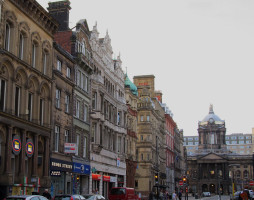 View north along Castle Street.
View north along Castle Street.
 View north along Castle Street.
View north along Castle Street.
Castle Street is a short, historic street leading from Liverpool’s Queen Victoria Memorial at the south end, to the Old Town Hall which closes off the north end, and in front of which Dale Street runs East-West. It contains a variety of Victorian buildings with decorative sculpture. We start from the southern end.
60-62 Castle Street, on corner with Derby Square, portico, spandrel girls, and bird capitals to pilasters.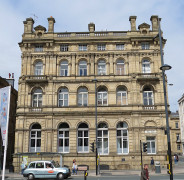
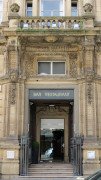
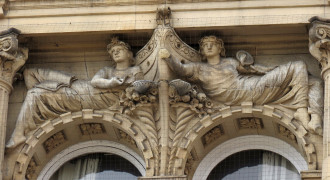
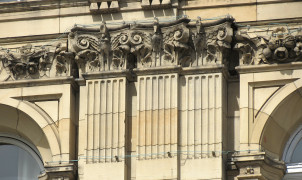
At this end, the older buildings are all on the left hand (west) side. The initial corner building, no.60-62, thus with the main entrance on Castle Street and the side on Derby Square/James Street, is a large, almost cubical honey-coloured stone building in Renaissance style, originally built for a provincial bank. It has many arched windows on three levels (two on the Castle Street frontage), with a shallow 3rd floor with rectangular windows, then a balustrade and tall chimneys. The principle sculptural decoration is around and above the portico onto Castle Street, including great stone heads as corbels to the supports of the balcony, an interior pair of male, bearded figures, and above the third floor, a pair of reclining girls supporting the prow of a ship (for more ship sculpture, see this page). These two are worth study. They lie on the tops of curved window openings, so encompassing both sides of the spandrel position, each with one leg down on the outer side of the arch, and the space on the inner side filled by a cornucopia with a bowl on top. She on the left has a star on her forehead, and a book lying open on her lap, most graceful. She on the right is more damaged, having lost a hand and part of one foot, and with some broken bowl on her arm, symbolism now obscure. Among more minor decoration, we may note a considerably variety of floral ornament, and stylised birds, herons perhaps at the tops of the pilasters, their wings being formed by the volutes (curls) of the capitals (see this page for a general note on pillar sculpture).
48-50 Castle Street by James Picton of Liverpool, with busts (described below, in order).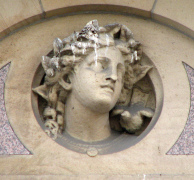
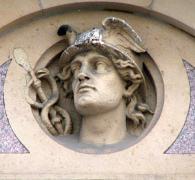
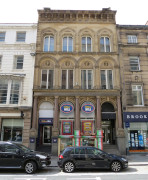
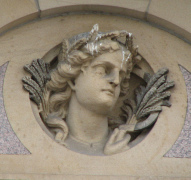
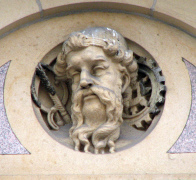
A couple of buildings along, no. 48-50, another Italianate effort four bays wide, has a bust in a roundel above each of the first floor windows. These are Classical, and show a goddess with a wreath of leaves, and a dove, thus presumably Aphrodite; Hermes (Mercury) with winged helmet and snake-entwined staff – though he should really have two snakes rather than one, as here, which is associated with Asklepius; a more mature goddess of the harvest (Demeter), with ripe corn and a sickle; and an older bearded male with toothed wheel and some pincer-like device, probably Hephaestus. The building, put up for the Mercantile and Exchange Bank of Liverpool, London and Glasgow, is a work of James A. Picton, a most notable Liverpool architect who also founded the Picton Library. We may note that the lower buildings on either side, though of no sculptural interest, are late 18th Century reminders that this was one of the main thoroughfares of the old town before it became the massive city of the 19th Century.
Details of 42 Castle Street, by Grayson & Ould, with mermen, and Lancaster coat of arms.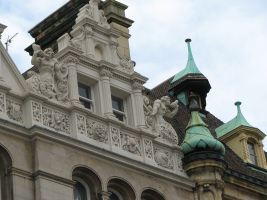
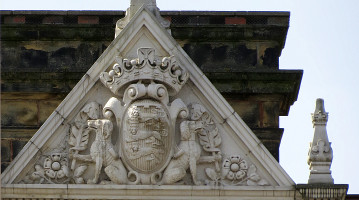
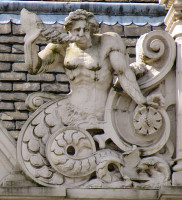
No. 42, opposite Cook Street – and it is worth going a few paces down that street to get far enough away to see the building properly – was originally Victoria Chambers, and is a grand late Victorian work by the partnership of Grayson and Ould, five bays wide, all pale stone Renaissance style, with at the top three gables with sculptural adornment, forming a splendid skyline with the adjacent buildings. The most prominent things are four full figure mermen, trumpeting on shells, with curled, stylised tails. They look somewhat distorted at casual glance from ground level, and in close up show a grotesque overdevelopment of their muscles. Lower down are similarly grotesqued mermen in relief (see this page for lots of mermen sculptures); and directly beneath the main figures are rather more carefully carved panels with a cormorant like bird symbolic of Liverpool, cartouche and so forth, and a female bust of no obvious affiliation – she is not Victoria. The central gable at the top contains the coat of arms of Lancaster, with carved heraldic dogs.
Adelphi Bank building, 42 Castle Street.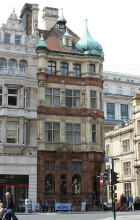
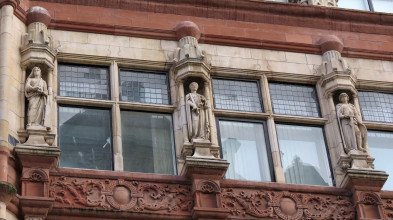
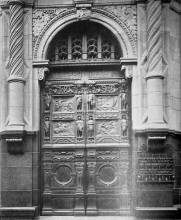
Directly attached to no. 42, no. 40 is the celebrated Adelphi Bank building, a branch of the Liverpool Banking Company, with a green ogee dome on the corner to Brunswick Street and a variety of other little fanciful spikes against the main mansard roof. The building is red terra cotta at ground level, with the upper floors in white stone, and red bands between the levels, all rather splendidly idiosyncratic. There are just a couple of bays to Castle Street, with the greater length, five bays, to Brunswick Street, and the main door on the corner. There is much busy surface decoration on walls, door and doorway, and five full figures in niches at second floor level: two to Castle Street, three to Brunswick Street. The bronze door – you need to see it when the premises are closed, of course – includes statuettes and low relief scenes in bronze on the subject of Adelphi (brothers) by Stirling Lee, to designs by the architect of the building, W. D. Caroe, with other metalwork by J. Starkie Gardner. The picture of the door above right is contemporary with the building's erection, and shows a metal grill on the right hand side which is no longer extant. More pictures of this building on this page.
C. R. Cockerell's Bank of England Liverpool branch. 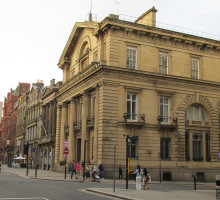
Before crossing over Brunswick Street, we should look behind us, for on the right hand side of the street is an important Classical building, which was built as the Liverpool branch of the Bank of England, the architect being C. R. Cockerell. With its portico of four attached Doric pillars, spare ornament at the corners and above each storey, it is considered a masterpiece of Victorian Neoclassical architecture. Like Hawksmoor in the late 17th and early 18th Centuries, Cockerell was able to convey a sense of mass and sheer size in a building that was not actually that large. Cockerell built two other branches for the Bank, in Manchester and Bristol, which like the Liverpool building date from the latter part of the 1840s, and also impressive.
36 Castle Street, with sculptural details.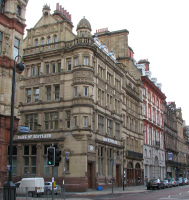
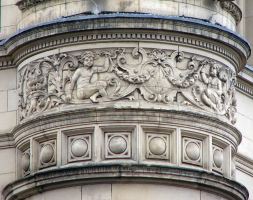
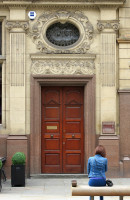
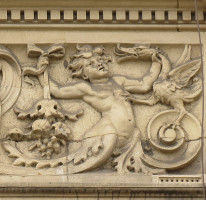
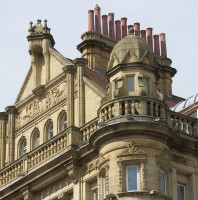
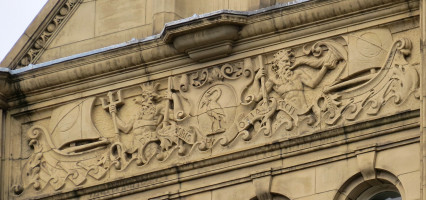
Back to the left hand side of Castle Street, where across Brunswick Street, thus facing the Adelphi Bank building, the corner building is no. 36, a great pile of a building, with a turret on the corner, and a gable to the Brunswick Street side, and some volume of decorative relief sculpture, consisting mostly of narrow panels with scrolls and festoons, among which are two seated putti on the turret, and on the main face of the building, several half-figures, birds, griffins and cornucopias, all too minor to be more than an accent on the mass of the architecture, but well executed in pale terracotta. Below the gable on the side is a further panel, showing a reduced coat of arms of Liverpool, with two mermen holding a central cartouche with a rendering of the Liver bird; one of the mermen blows a great trumpet, and the other is a more Neptunelike figure, crowned and bearing a trident. To the sides are seen the front parts of ships, with both sails and paddles. The building is dated 1895.
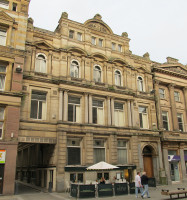
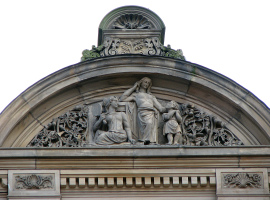 25 Castle Street, and the pediment sculpture.
25 Castle Street, and the pediment sculpture.
Back on the right hand side, the building after Cockerell’s Bank of England has Corinthian pillars and a pediment with scrolling, and the one after that, no. 25 Castle Street, has a round-headed pediment with a figural group of sculpture. The central female figure wears just a long skirt, her upper body and feet being bare. She stands with one foot slightly raised on a platform, looking downwards, and slightly towards a child around whose shoulder she places one arm; the child clasps his hands together and looks up at her. On her other side, a girl holding a mirror is seated on the platform, behind her some plinth or shelf on which the central figure rests her elbow, her hand holding her hair. The figures appear somewhat crudely carved, but there has been some weathering, and the oblique view we have makes it hard to see if the proportions feel right, but the arms of the central figure look very long, and certainly there is a high degree of muscularity to the figures, with mannish arms and shoulders. To the sides of the grouped figures are deeply undercut thistle leaves and flowers. What are we to make of this scene? The mirror of the seated figure and the braiding of the hair by the central one suggest Vanity, but the child suggests some aspect of nurture or protection, as might be suitable for an insurance company. Odd.
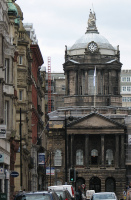 The Old Town Hall, view from Castle Street.
The Old Town Hall, view from Castle Street.
We do not describe the Old Town Hall on this page, but it is from about this distance that it looks at its best, almost filling the view at the northern end of Castle Street, and with its seated figure of Britannia on the summit dome, the work of the most excellent sculptor J. C. F. Rossi.
Two more buildings to note. Back on the left hand side, the former Cheltenham and Gloucester Building Society building, no. 6-8 Castle Street, has small low relief panels above the second floor, with the central one containing a castle, acknowledging the name of the street, and at the top of the two-storey Ionic structure, a greatly-broken curved leaf-filledpediment, the centre being occupied by an upthrust structure containing an attic window and with its own smaller open curved pediment. Somewhere between Edwardian Baroque at the macro level and Art nouveau in the detail, and the date at the top is 1897.
Cheltenham & Gloucester building, with castle in low relief; and 3-5 Castle Street with one of the mosaics.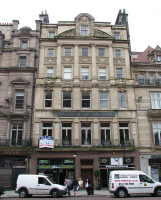
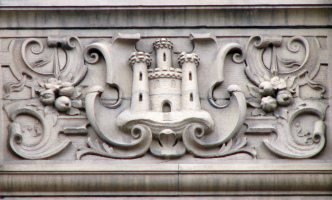
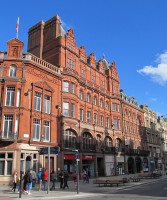
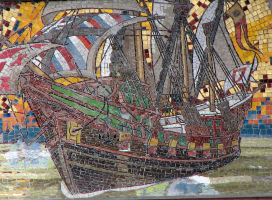
And finally, nos. 3-5 Castle Street, on the right hand side, is the former British and Foreign Marine Insurance Company building, a red terra cotta effort which like its lower and equally red neighbour is the work of the architectural partnership of Grayson and Ould, from the late 1880s, and includes a variety of small terra cotta decorations of high quality, and a mosaic frieze – again, a brief separate page covers this building, and if you like architectural mosaics, a brief introduction to such things from a London perspective is on this page.
Adelphi Building, 40 Castle Street // 3-5 Castle Street // Liverpool's Queen Victoria Memorial // Other Liverpool sculpture
Statues in English towns // Sculpture pages
Visits to this page from 24 Nov 2013: 1,510 since 21 September 2024